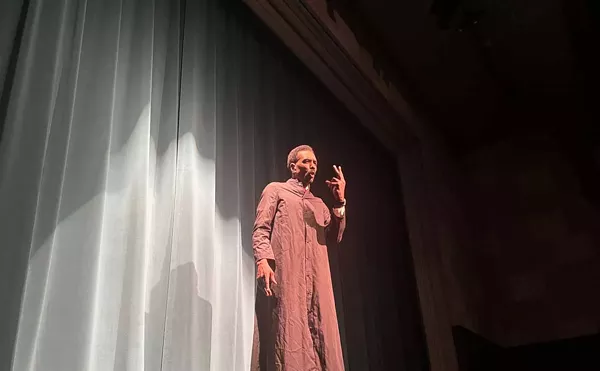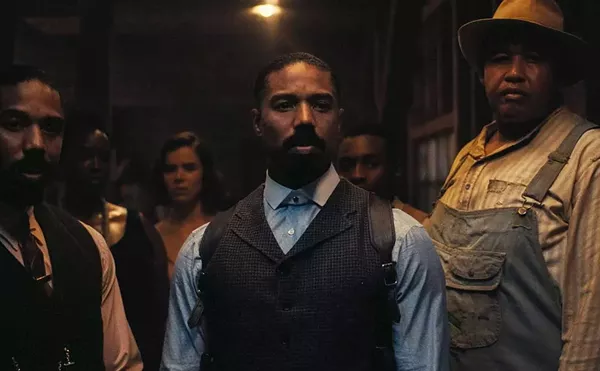
Audio By Carbonatix
[
{
"name": "GPT - Leaderboard - Inline - Content",
"component": "35519556",
"insertPoint": "5th",
"startingPoint": "3",
"requiredCountToDisplay": "3",
"maxInsertions": 100,
"adList": [
{
"adPreset": "LeaderboardInline"
}
]
}
]
“The history of Detroit-Windsor is visible — it’s right in your face. I use it as a microcosm for existence in my work,” says Canadian multimedia artist Christine Burchnal, speaking of our unique transborder relationship in such terms as “exotic” and “sad.” At this moment she’s thinking as a maker of photographic images, not as the arts organizer she is most of the working week.
As administrative director of Artcite, the multiarts project at 109 University W. (519-977-6564) in our sister city south of the river, Burchnal is consumed with ideas of “risk-taking and relevance, living arts and living culture, not looking back but to the here and now.” Artcite is home to the annual Media City experimental film festival, the House of Toast film and video collective, the Son ov Noise music fest and a rotating schedule of contemporary exhibitions and performances that makes it a destination for the more adventurous international artgoer.
Raised and educated in Edmonton, Alberta, Burchnal got a bachelor’s in fine arts in printmaking and painting from the University of Alberta in 1981 and began working on an master’s in fine arts at the University of Windsor the same year. By 1983, when she finished her studies, she was already hooked on the strange brew of American and Canadian culture that she found in this greater-than-the-sum-of-its-parts megalopolis. Eventually she joined up with Detroit filmmaker Bob Andersen and Windsor artist Chris McNamara in a transnational mind-bending venture called E-I-E-I-O (the Evidence Institute for Extraordinary Industrial Observations).
So Burchnal seemed an ideal companion for a tour of the recently relocated Art Gallery of Windsor, which has been in its imposing new home at 401 Riverside Drive W. (519-977-0013) since February 2001. As an artist and curator, she’s someone with insights and suggestions (welcome or not) for the curatorial powers that be.
Approaching the AGW from the large parking lot on its south side, we get a dramatic view of its silhouette before the expanse of the Detroit River. From this angle, its massive, shiplike geometry dances a spotlighted solo among the corps de ballet of the Detroit skyline. Burchnal quips that it seems to have been designed to contrast with the RenCen towers.
Inside the AGW, another saga of space unfolds. The museum’s information desk is a brief stopover within an enormous ship-shaped central hall. And a few giant steps further on, a gargantuan stairway rises uninvitingly, as if “Jack and the Beanstalk”’s nemesis were about to come down to meet us. Ironically, this all leaves little exhibition space at ground level, aside from a room of recent additions to the collection and a multipurpose auditorium.
And there are other, environmental issues that Burchnal points out: “There’s a problem with climate control, so you notice that here on the main floor there’s not much art on the walls, especially in the ‘ship’ area. And that’s because of problems with humidity and heating and cooling. They can’t be controlled properly down here or in the glass-enclosed stairwells, leaving works on paper particularly vulnerable. And the ‘vitrine gallery,’ which was intended to be seen from outside the building and to feature Windsor artists, has problems of visibility. You can only see into the windows at night.”
An elevator takes us to the second-floor galleries, devoted through May 26 to “Out There is Somewhere: The Arctic in Pictures,” a wonderful exhibition exploring both Inuit and non-Inuit depictions of the great white North. It’s a uniquely Canadian show, involving issues of Canadian identity and cultural definitions from a whole range of perspectives.
“One thing that’s striking,” says Burchnal, “is to see works from the permanent collection and the Lawren Stewart Harris paintings [exhibited on the third floor through April 21] in combination with works from Inuit artists. The historical overview is great.
“There’s more of a museological than a strictly ‘art gallery’ approach in this show, because you have a lot of archival photographs. I think the show’s all about context and revisiting history, not rewriting it. And there’s an educational aspect at AGW that’s always tied in, with an effort to animate the exhibits with lectures and other events.”
But before we leave the second floor, Burchnal calls attention to the white noise that pervades the AGW at almost all levels: “Did you notice the air circulation fans in this space? The sound is pretty intrusive — it’s not conducive to contemplation by any stretch.”
In the more intimate third-floor galleries, among Lawren Harris’ spiritual revelations — paintings that, in Burchnal’s words, “strip things down to their essence” — we unpack some of the political concerns of the Windsor art community. Is there a feeling of antagonism between the city’s contemporary artists and the AGW?
“Let’s say we’re all taking a wait-and-see attitude,” says Burchnal. “We’re worried about what will happen to contemporary art at the museum, and what will happen to the commitment to local artists — so that we’re not ghettoized, so that we get legitimate shows.
“One local artist, Julie Sando, did have a show here and her name keeps being brought up as proof positive that the Gallery is in fact programming contemporary work by local artists.”
In a museum with an active and varied exhibition schedule, available space is being utilized with hardly any of the same works remaining on view for long. Burchnal admits that there’s a sense of vitality at the AGW:
“They keep things pretty much in rotation — that’s the stated intention. The new director [Glen E. Cumming] has indicated that that’s definitely what he wants to do — keep it fresh, keep it changing.”
So are Windsor artists in a love-hate relationship with AGW?
“Again, we don’t know yet … perception is everything. When we see that certain contemporary shows are not happening, that there’s a tendency to show more of the permanent collection, to show more historical works — because that’s what ‘the public’ wants to see — our reply is, ‘Who’s the public? There are 50 publics.’
“A recent show, ‘Rae Davis: Unfoldings,’ was touted as a contemporary show. It was actually a historical overview of the last 25 years of a senior artist’s work.”
Making and exhibiting art in Windsor-Detroit, in Burchnal’s experience of our borderline situation, involves a “crisis of meaning.” Her impatience with AGW’s programming is part of a worldview in which cultures clash and influences seem to flow in mainly one direction.
“Whenever we look to promote things, we always look to Detroit first … But our place in the cultural makeup is even more important in Windsor, because we’re sort of gatekeepers to Canada — an idea as hokey as that. It’s very important that we try to maintain our Canadian identity here, even doubly so, because we’re so overwhelmed by American media.
“The AGW should not be just a building. It should have outreach programs and be a center of community activity and dialogue. That’s what’s important.”

This is the second in a series of visits in which curators from alternative art spaces take a critical look at major regional art centers. Be sure to read the others:
• "Got art?" (4/3/02) — Up-and-coming art curator Aaron Timlin looks long and hard at the DIA’s modern collection.
• "Epiphany in Treetown" (4/17/02) — Painter and curator Jocelyn Rainey finds heaven at the U of M Museum of Art.
• "Minding the art" (4/24/02) — CCS instructor and Tangent Gallery curator Mitch Cope explores the diverse and challenging works displayed at Cranbrook Art Museum.
George Tysh is Metro Times' arts editor. E-mail him at gtysh@metrotimes.com




